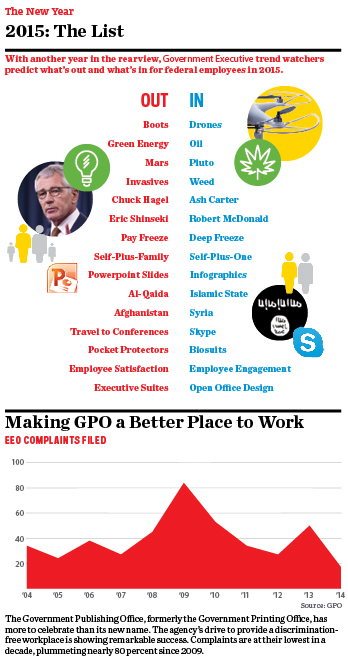
Parting is bittersweet for Patrick Donahoe, who devoted 39 years to the Postal Service. Charles Dharapak/AP
What a Long, Strange Route It’s Been
Patrick Donahoe strived to be the Postal Service’s bridge over troubled waters.
By Eric Katz
Nearly every time Patrick Donahoe makes a public appearance, he asks those who are listening to raise their hands if they still pay their bills through the mail.
Without fail, in each instance, very few hands go up, and the outgoing postmaster general wistfully notes he still puts his checks in his mailbox each month.
Such is the dilemma for a man who spent his entire 39-year career at the U.S. Postal Service, climbing his way from a mailroom in Pittsburgh to become the 73rd man to lead the agency. He balances a fanatical love for the mail and the only organization legally permitted to deliver it with the countervailing reality that ever fewer people use it like they used to.
Donahoe, in his four-plus years as postmaster general, has had little time for nostalgia. He has instead been forced to slash services, shutter facilities and cut more jobs than any postal leader in the agency’s storied history to offset shrinking mail volumes.
He has no regrets.
“We made a lot of tough decisions that were based on a long-term view of what was right for the organization,” says Donahoe, who will leave USPS in February. “We used every bit of flexibility we had—as we should have.”
The career postal man has reason to defend his legacy: In fiscal 2014, for the first time in years, USPS turned a profit in its controllable costs. Whether that will translate into newfound relevance for one of America’s oldest institutions, however, will soon be someone else’s problem.
A Snapshot of Government’s Future
In an age of listicles, memes and instant online access, a top consultant to agency planners has attempted to package insights into the government’s future on a single website.
Gov2020 “brings together in one easily navigable place a treasure trove of analysis and creative visualizations about the future,” says William Eggers, architect of the site and director of public sector research at Arlington, Va.-based Deloitte Service LP. Enriched with colorful infographics, photos and videos, the interactive site groups 193 drivers and 36 trends in education, human services, defense, transportation and hiring.
For example, Deloitte’s research shows that “rapid globalization, technology advances, geographic mobility and innovation in education are transforming the concept of work. Governments expand their talent networks to include partnership talent (employees who are parts of joint ventures), borrowed talent (employees of contractors), freelance talent (independent, individual contractors) and open-source talent (people who don’t work for you at all, but are part of your value chain and services),” the site says.
Gov2020 offers links to additional information and invites input from readers. “We received dozens of emails and notes from government officials already about the site,” Eggers says. “The comments seem to fall into three buckets: Those who see all sorts of opportunities embodied in the trends; those who see potential threats embodied in some of the drivers of change, whether to privacy or security; and those who want to know how to get from where they are now” to where they want to be.
- Charles S. Clark
From SEALs to Eels?
In the decade ahead, unmanned underwater vehicles, or UUVs, may have the same sort of disruptive effects on militaries as their flying counterparts. More than 12 countries are at work on undersea robots, which some militaries, including the United States, use to check for mines, map the sea floor and collect weather data. There’s no reason they couldn’t be used to defend battleships from small boats or even carry out attacks on enemy divers. But what will they look like? A team of researchers from Singapore led by Jianxin Xu recently debuted a robotic eel design prototype that could signal the future of undersea warfare.
“Anguilliform [eel like] fish consume less energy when on a long distance journey than regular autonomous underwater vehicles,” Xu told Defense One. “They are highly maneuverable and flexible, making them more suitable than Gliders for navigating small spaces . . .The noiseless propulsion is another advantage” for the military, he says. “They’re less detectable than robot subs that propel themselves the same way as conventional subs.”
With an oceanic menagerie of animals to choose from for future robot designs, what advantage do eels present over other forms?
Eel bots can explore difficult to navigate reefs, hulls and undersea geological formations in a way that other fish types can’t. Xu says that future prototypes of his robot will require less and less guidance to operate. They’ll self-navigate through difficult or dark crawl spaces, which also means fewer operators presiding over more robots, potentially making them even more cost efficient for the Navy.
But the eel bot’s most attractive feature is its adaptability. The same undulating movement that propels it through water can move it forward on land as well. It’s one reason NASA was considering snakebots for future Mars missions and why tomorrow’s amphibious assault weapons may not swim, walk or roll but . . . slither.
- Patrick Tucker

NEXT STORY: Raising Human Capital






